 W
WThe Merchant Court is a network of fortified depots built on the Pur-Navolok promontory in Arkhangelsk by a team of German and Dutch masons between 1668 and 1684. Only the northern tower of the original structure and parts of the western wall facing the Northern Dvina still stand.
 W
WThe Baroque fortifications in the Black Forest, also called Baroque Schanzen (Barockschanzen) or Black Forest lines (Schwarzwaldlinien), are historical, military earthworks, known as schanzen, that were built in the Black Forest in what is now Germany. They were built in the 17th century to defend the Margraviate of Baden from French invasion. Together with their adjoining defensive lines, the Black Forest fortifications formed a defensive system over 200 kilometres long that ran from north to south.
 W
WThe Baluarte de San Ignacio is a bastion located in Cartagena de Indias, in Colombia. This bastion, originally called the Bastión de los Moros, is located on the side of the House of the Jesuits and is the work of Cristóbal de Roda.
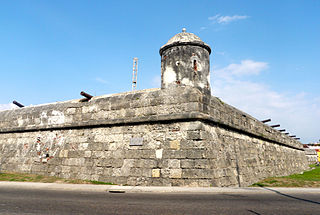 W
WThe Baluarte de Santo Domingo is a bastion located in Cartagena de Indias, in Colombia. The bastion of Santo Domingo has a particular importance, since it is the origin of the construction of the city walls of Cartagena de Indias in the early 17th century. This work of fortification was conceived around 1602 by the engineer Battista Antonelli and his nephew Cristóbal de Roda, also engineer, who decided to build it on the avenue through which the pirate Francis Drake had penetrated, in 1586.
 W
WThe Fort de Bellegarde is a 17th-century bastion fortification located above the town of Le Perthus, in the Pyrénées-Orientales département of southern France.
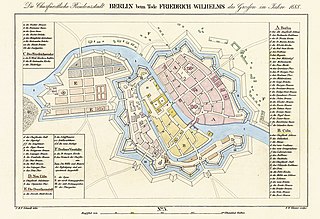 W
WThe Berlin Fortress was the fortification of the historic city of Berlin. Construction started in 1650. The demolition of its ramparts began in 1740.
 W
WBohus Fortress lies along the old Norwegian–Swedish border in Kungälv, Bohuslän, Sweden, north east from Hisingen where the Göta river splits into two branches. It commands the surrounding area from a cliff 40 m (130 ft) high, with the river forming a natural moat around it.
 W
WThe Castello di Punta Pagana is a 17th-century fort located on the homonymous Punta Pagana, within the grounds of Villa Pagana in Rapallo, within the Metropolitan City of Genoa in Italy. It is located west of San Michele di Pagana, close to the boundary with Santa Margherita Ligure. The fort was originally built by the Republic of Genoa, and today it belongs to the Sovereign Military Order of Malta along with the rest of the villa.
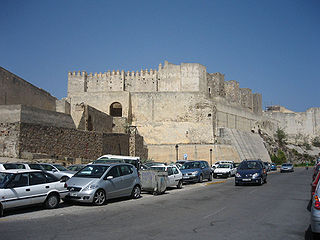 W
WThe Castle of Tarifa, also known as Castle of Guzmán el Bueno or Castle of the Guzmáns is a castle in the coastal town of Tarifa in Spain.
 W
WChandragiri Fort is a fort built in the 17th century, situated in Kasaragod District of Kerala, South India. This large squarish fort is 150 feet (46 m) above sea level and occupies an area of about seven acres by the side of the river Payaswini. The fort is now in ruins.
 W
WThe Cittadella, also known as the Castello, is the citadel of Victoria on the island of Gozo, Malta. The area has been inhabited since the Bronze Age, and the site now occupied by the Cittadella is believed to have been the acropolis of the Punic-Roman city of Gaulos or Glauconis Civitas.
 W
WThe Cottonera Lines, also known as the Valperga Lines, are a line of fortifications in Cospicua and Birgu, Malta. They were built in the 17th and 18th centuries to form the outer defences of the Three Cities of Birgu, Senglea and Cospicua. They surrounded an earlier line of fortifications, known as the Santa Margherita Lines.
 W
WThe Floriana Lines are a line of fortifications in Floriana, Malta, which surround the fortifications of Valletta and form the capital city's outer defences. Construction of the lines began in 1636 and they were named after the military engineer who designed them, Pietro Paolo Floriani. The Floriana Lines were modified throughout the course of the 17th and 18th centuries, and they saw use during the French blockade of 1798–1800. Today, the fortifications are still largely intact but rather dilapidated and in need of restoration.
 W
WFort Fuentes, Italian: Forte di Fuentes, is a former military fort on the hill of Montecchio or Monteggiolo near Colico, in the province of Lecco, Lombardy, northern Italy.
 W
WFort Ricasoli is a bastioned fort in Kalkara, Malta, which was built by the Order of Saint John between 1670 and 1698. The fort occupies a promontory known as Gallows' Point and the north shore of Rinella Bay, commanding the entrance to the Grand Harbour along with Fort Saint Elmo. It is the largest fort in Malta, and it has been on the tentative list of UNESCO World Heritage Sites since 1998, as part of the Knights' Fortifications around the Harbours of Malta.
 W
WFort San Lucian, also known as Saint Lucian Tower or Fort Rohan, is a large bastioned watchtower and polygonal fort in Marsaxlokk, Malta. The original tower was built by the Order of Saint John between 1610 and 1611, being the second of six Wignacourt towers.
 W
WFort St. Angelo is a bastioned fort in Birgu, Malta, located at the centre of the Grand Harbour. It was originally built in the medieval period as a castle called the Castrum Maris. It was rebuilt by the Order of Saint John as a bastioned fort called Fort Saint Angelo between the 1530s and the 1560s, and it is best known for its role as the Order's headquarters during the Great Siege of Malta of 1565. A major reconstruction to designs of Carlos de Grunenbergh took place in the 1690s, giving the fort its current appearance.
 W
WThe fortifications of Copenhagen underwent a comprehensive modernization and expansion in the 17th century. The project was commenced and was largely the masterplan of Christian IV in the early 17th century but was continued and completed by his successors. The new fortifications relied on the existing, medieval fortifications of the city but the fortified area was extended and a defensive ring around the city completed particularly with new edifices facing the sea. The ring fortification consisted of four bastioned ramparts and an annexed citadel as well as various outworks.
 W
WThe fortifications of Mdina are a series of defensive walls which surround the former capital city of Mdina, Malta. The city was founded as Maleth by the Phoenicians in around the 8th century BC, and it later became part of the Roman Empire under the name Melite. The ancient city was surrounded by walls, but very few remains of these have survived.
 W
WThe fortifications of Senglea are a series of defensive walls and other fortifications which surround the city of Senglea, Malta. The first fortification to be built was Fort Saint Michael in 1552, and the majority of the fortifications were built over the next decade when it was founded by Grand Master Claude de la Sengle. Modifications continued until the 18th century, but large parts of the fortifications were demolished between the 19th and 20th centuries. Today, all that remain of Senglea's fortifications are the seaward bastions and part of the land front.
 W
WThe fortifications of Valletta are a series of defensive walls and other fortifications which surround Valletta, the capital city of Malta. The first fortification to be built was Fort Saint Elmo in 1552, but the fortifications of the city proper began to be built in 1566 when it was founded by Grand Master Jean de Valette. Modifications were made throughout the following centuries, with the last major addition being Fort Lascaris which was completed in 1856. Most of the fortifications remain largely intact today.
 W
WThe Tower House of Garcia d'Avila, also known as the Castelo de Garcia d'Ávila, Forte de Garcia d'Ávila, is a 17th-century building complex in Mata de São João, Bahia, Brazil. It was constructed in the present-day settlement of Praia do Forte, 1,200 metres (3,900 ft) from a small natural harbor on the Atlantic coast. Tomé de Sousa (1503-1579), the first governor-general of Brazil, appointed his son Garcia de Sousa d'Ávila (1528-1609) to build a fortress on the Bahia coast. The castle sits on a hill with a good view of the Atlantic Ocean; the castle, as well as the village of Tatuapara, served as an advanced point of vigilance for Salvador and settlements around the Bay of All Saints. Alerts of the approach of enemy ships were sent from the castle to Salvador via encrypted messages of smoke and torches; they traveled from the castle through a chain of Jesuit villages and other small settlements until they reached Salvador.
 W
WGarzes Tower, also known as Saint Martin's Tower, was a watchtower built in Mġarr, Gozo by the Order of Saint John in 1605. It was named after Martin Garzez, the Grand Master who financed its construction, even though it was eventually built after his death during the Magistry of Alof de Wignacourt. The tower was demolished in the 19th century, some remains were reused for the building of a bridge, and the site was developed with a hotel.
 W
WFortifications of Gothenburg were initially embankments along the newly dug city moat (Vallgraven) in Gothenburg, Sweden. They were built to defend Gothenburg which was Sweden's only direct access to the North Sea and Atlantic Ocean.
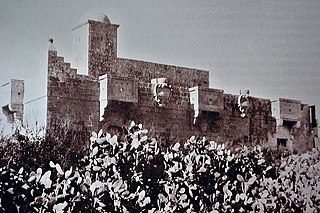 W
WGourgion Tower was a fortified house in the outskirts of Xewkija, Gozo, Malta. The tower was built by Giovanni Gourgion in 1690, and it became a symbol of the village of Xewkija. Despite being listed on the Antiquities List in 1925, it was demolished by American forces in 1943 to make way for an airfield for the Allied invasion of Sicily.
 W
WKasbah of Le Kef is a kasbah fortification in the city of El Kef, Tunisia. The kasbah was constructed in 1600 during the Ottoman rule of the local tribes and borders, as one of the many forts established for the monitoring of the local area. It played a major role in the defense of the city as well as administration which was conducted from the fort.
 W
WThe fortifications of the former East Prussian capital Königsberg consist of numerous defensive walls, forts, bastions and other structures. They make up the First and the Second Defensive Belt, built in 1626—1634 and 1843—1859, respectively. The 15 metre-thick First Belt was erected due to Königsberg's vulnerability during the Polish–Swedish wars. The Second Belt was largely constructed on the place of the first one, which was in a bad condition. The new belt included twelve bastions, three ravelins, seven spoil banks and two fortresses, surrounded by a water moat. Ten brick gates served as entrances and passages through defensive lines and were equipped with moveable bridges.
 W
WKotta mara is a type of floating battery or fortified raft from Borneo. It is used by native Bornean in warfare, its usage rose prominently during the Banjarmasin war (1859-1906). Kotta mara is used in riverine warfare, as an armed vessel or simply a blockhouse or fortification to prevent enemy advance in the river.
 W
WMamo Tower, also known as San Tommaso Tower, is a fortified residence in Marsaskala, Malta. It was built by the Mamo family in 1657 on rising ground above St Thomas Bay on the east shore of Malta.
 W
WMingary Castle, also known as Mingarry Castle, is a castle situated a mile south-east of the small village of Kilchoan in Lochaber, Scotland. Nestled on ridge of rock overlooking the sea, it was considered a strategically important site in terms of communication with overseas areas and as an entranceway to the Sound of Mull. Mingary is roughly hexagonal in shape with nine-foot-thick walls, thicker on the seaward side. The remains of the castle are protected as a category A listed building.
 W
WThe Puerta del Reloj Spanish pronunciation: [ˈpweɾta ðel ˈrelox], Torre del Reloj Spanish pronunciation: [ˈtore ðel ˈrelox] or Boca del Puente Spanish pronunciation: [ˈboka ðel ˈpwente] is the main city gate of the historic center of Cartagena de Indias, in Colombia and the original entrance of the fortified city. It is located between the squares Plaza de Independencia and Plaza de los Coches. The name "Puerta del Reloj" responds to the clock with which it was crowned at the beginning of the 18th century. While the name of Boca del Puente is due to the fact that during the colonial period, a drawbridge was raised at the foot of the channel of San Anastasio, which linked the walled city to the legendary Getsemaní neighborhood. In addition the bridge served like defense of the city, since in case of enemy attack, this one was raised to prevent the access of buccaneers and pirates.
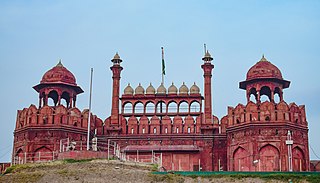 W
WThe Red Fort is a historic fort in the city of Delhi in India that served as the main residence of the Mughal Emperors. Emperor Shah Jahan commissioned construction of the Red Fort on 12 May 1638, when he decided to shift his capital from Agra to Delhi. Originally red and white, its design is credited to architect Ustad Ahmad Lahori, who also constructed the Taj Mahal. It was constructed between May 1639 and April 1648.
 W
WSanta Cecilia Tower is a tower in Għajnsielem, Gozo, Malta. It was built in 1613 by a member of the Order of St. John, and it could relay messages across the island. Today, the tower is in good condition and it is a private residence.
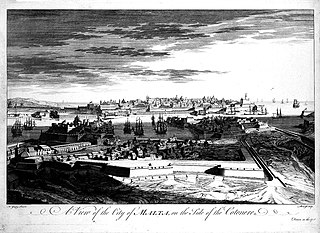 W
WThe Santa Margherita Lines, also known as the Firenzuola Lines, are a line of fortifications in Cospicua, Malta. They were built in the 17th and 18th centuries to protect the land front defences of the cities of Birgu and Senglea. A second line of fortifications, known as the Cottonera Lines, was later built around the Santa Margherita Lines, while the city of Cospicua was founded in the 18th century within the Santa Margherita and Cottonera Lines.
 W
WSão Marcelo Fort, also known as Forte de Nossa Senhora do Pópulo e São Marcelo or Forte do Mar, is located in Salvador in Bahia, Brazil. It is located in small bit of land off the coast in the Baía de Todos os Santos. Standing on a small bank of reefs about 300 metres (980 ft) from the coast, it is one of two forts separated by water from land in Brazil, the other being the Fort Tamandaré da Laje Tamandaré in Rio de Janeiro. It is the only cylindrical fort in Brazil. Its design follows those of Castel Sant'Angelo in Italy and São Lourenço do Bugio Fort in Portugal. It is popularly known as the "Forte do Mar". It was built to protect the important port city Salvador from threats; the city had the largest number of forts during the colonial period of Brazil.
 W
WSkansen Kronan is a redoubt in the district of Haga of Gothenburg, Sweden.
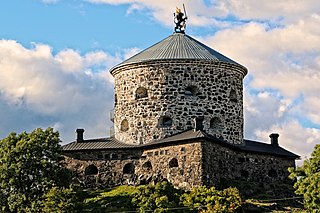 W
WSkansen Lejonet ("the Lion sconce") is a redoubt in Gothenburg, Sweden, built in 1687. Since 1822 it has served other purposes.
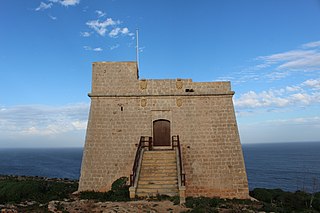 W
WSopu Tower, also known as Isopu Tower, San Blas Tower or Torre Nuova, is a small watchtower situated on the cliff between San Blas and Daħlet Qorrot in Nadur, Gozo, Malta.